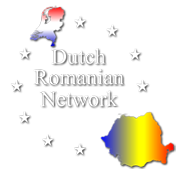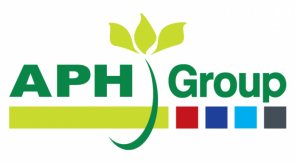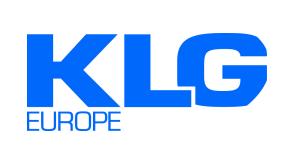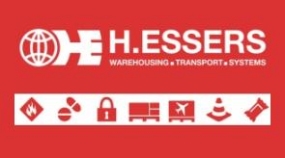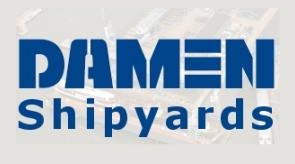Newsletter May 2025

In this newsletter, information on:
Water Sector | Romanian Agricultural Mechanizations Sector | Infrastructure Sector in Central Europe
Financial Sector | Transport & Logistics Sector
Automotive Sector | Agra rical Sector | S ector Shipbuilding | Post Craiova
Water Sector
Drought hits Romania hard: water is rationed
More than 580 localities are in the water supply phase with 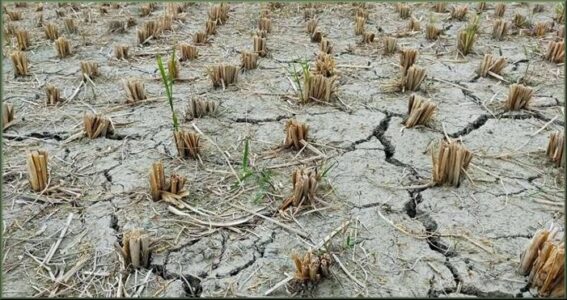 restrictions, in most provinces of Botoşani, Vrancea, Vaslui, and Iaşi.
restrictions, in most provinces of Botoşani, Vrancea, Vaslui, and Iaşi.
Drought hits Romania hard: water is on ration in more than 600 localities
Neamţ and 41 towns along the Danube have entered the warning phase, the National Administration “Apele Române” (ANAR) announced in a press release.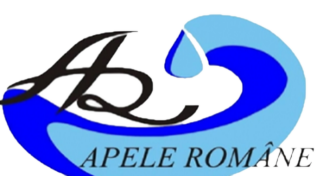
“We continue to monitor with high frequency how water sources are exploited and how water needs are met, as well as how the provisions of the Water Mitigation and Use Plan are applied in periods of scarcity,” he said. Currently, the fill rate in the 40 reservoirs (managed by AN Apele Române together with SC Hidroelectrica SA) is 78.14%, down from last week, when it was 78.59%,” the source cited.
(For more information on irrigation see APH Group from Heerenveen and with Romanian branches in Târgu Secuiesc and Slobozia)
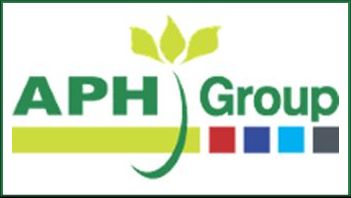 “Water volume in the main lakes is about 3.39 billion cubic meters (down from 3.46 billion cubic meters at the beginning of the month). Although water resources are declining, we are centrally providing raw water needs for beneficiaries from the surface water source. We estimate that by the end of August there will be a fill rate of about 75% in the 40 main reservoirs, which play an important role in water supply for the population and industry and electricity production for the national energy system,” the specialists said.
“Water volume in the main lakes is about 3.39 billion cubic meters (down from 3.46 billion cubic meters at the beginning of the month). Although water resources are declining, we are centrally providing raw water needs for beneficiaries from the surface water source. We estimate that by the end of August there will be a fill rate of about 75% in the 40 main reservoirs, which play an important role in water supply for the population and industry and electricity production for the national energy system,” the specialists said.
Drought affects transportation on the Danube: people have difficulty reaching the Delta.
Drought hits Romanian agriculture. Government announces compensation
Romanian agricultural mechanizations sector
Romania ranks last in the EU in terms of agricultural machinery
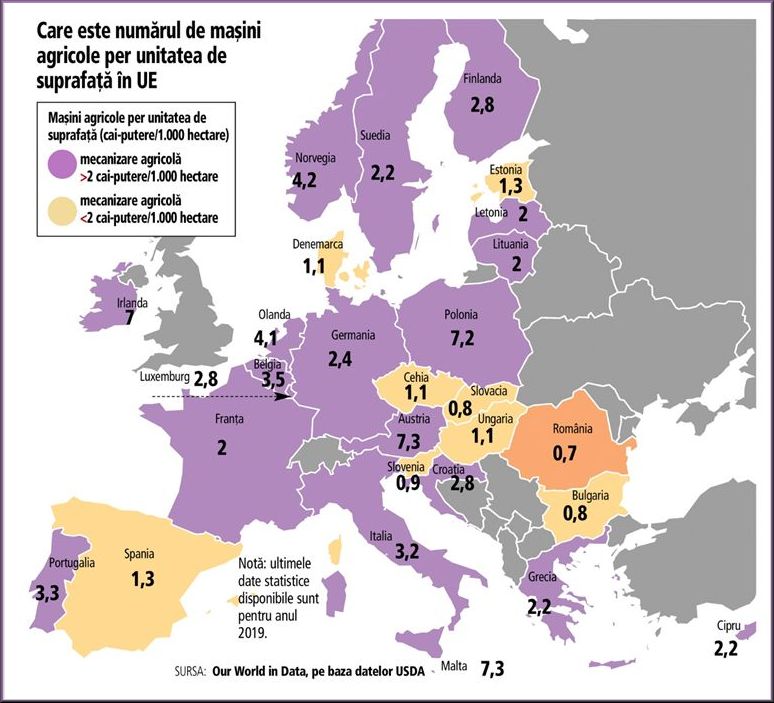
Romania has the lowest level of agricultural mechanization in the European Union, with only 0.73 CP/1,000 ha, compared to 7.1 CP/1,000 ha in Switzerland, 4.1 CP/1,000 ha in the Netherlands and 2 CP/1,000 ha in France, according to an analysis by Our World in Data, based on data collected by the Economic Research Service of the U.S. Department of Agriculture (USDA). In 1991, Romania had 0.5 CP/1,000 ha, but the current situation shows an improvement over the past three decades.
At first glance, it also seems like good news for the environment. But a closer look reveals that Romania is failing to catch up with the West, despite all the European funds available to modernize farms and provide them with new equipment. However, the situation is not universal. Large farms in Romania cultivate thousands of hectares with high-quality equipment, but they are few and far between.
In contrast, small farms, over 2.9 million in number, are still poorly equipped and lag behind in mechanization.
Infrastructure Sector in Central Europe
“Cinderella of the highways”
Moldova, the “Cinderella of highways,” surpassed Transylvania in the number of kilometers under construction or under contract.
Moldova has now become the area attracting the greatest investment in this area. With nearly 500 kilometers in the making.
Ilie Bolojan on the Three Seas Initiative: For Romania, the Via Carpathia and Rail-2-Sea infrastructure projects remain priorities. He praised former President Klaus Johannis and also Romanian European Commissioner of Transport Adina Valean who were the driving forces behind these initiatives during the Three Seas Initiative Economic Forum.
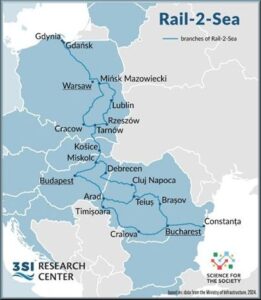 Interim President Ilie Bolojan recently participated in Warsaw in the section for heads of state and government within the Three Seas Initiative Business Forum. He stated that we are going through a complicated period of elections, where new realities are affecting our countries and the economic landscape is being reshaped. According to the head of state, the Three Seas Initiative is becoming increasingly relevant and connectivity is at its core. Moreover, the potential of our region is enormous. Bolojan also said that Romania, because of its geographical location and economic capacity, plays an important role Ilie Bolojan warned that the government is at risk of becoming a “payments agency.” “We spent more than we could spare” “I am happy to participate today in the Economic Forum of the Three Seas Initiative, a project of great importance for our region. The theme of this panel – connectivity for development – must be placed in the current context.
Interim President Ilie Bolojan recently participated in Warsaw in the section for heads of state and government within the Three Seas Initiative Business Forum. He stated that we are going through a complicated period of elections, where new realities are affecting our countries and the economic landscape is being reshaped. According to the head of state, the Three Seas Initiative is becoming increasingly relevant and connectivity is at its core. Moreover, the potential of our region is enormous. Bolojan also said that Romania, because of its geographical location and economic capacity, plays an important role Ilie Bolojan warned that the government is at risk of becoming a “payments agency.” “We spent more than we could spare” “I am happy to participate today in the Economic Forum of the Three Seas Initiative, a project of great importance for our region. The theme of this panel – connectivity for development – must be placed in the current context. 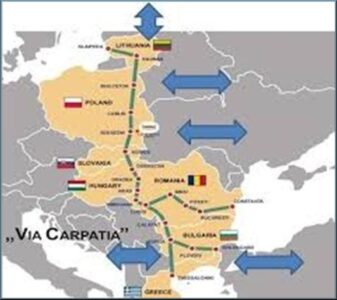 We are going through a complex period, where new realities affect our countries and the economic landscape is constantly changing, forcing us to constantly adapt. The decisions and measures we take at this stage will determine not only the future of the Three Seas Initiative, but also the future of Europe,” Bolojan said in his speech. The interim president noted that “the reconfiguration of political and economic forces at the global level requires strengthening partnerships with all countries interested in the stability and prosperity of our region.” “Under these circumstances, the Three Seas Initiative gains relevance. Connectivity is its essence and the potential of our region is enormous. Romania, due to its geographical location and economic capacity, plays an important role in this equation,” the head of state emphasized. Ilie Bolojan presented a number of priority directions for Romania. Regarding the interconnection of energy resources, Bolojan said Romania has succeeded in developing important projects in the energy field in cooperation with private companies. “The plan to build reactors 3 and 4 at the Cernavoda nuclear power plant takes important steps. In the area of natural gas extraction in the Black Sea, the strategic Neptun Deep project continues. This project is essential for regional energy security and we estimate that production will begin in 2027. It is essential to develop energy corridors on as many axes as possible and increase our energy security. On gas transportation corridors at the regional level, Romania benefits from its strategic positioning,” the president stressed.
We are going through a complex period, where new realities affect our countries and the economic landscape is constantly changing, forcing us to constantly adapt. The decisions and measures we take at this stage will determine not only the future of the Three Seas Initiative, but also the future of Europe,” Bolojan said in his speech. The interim president noted that “the reconfiguration of political and economic forces at the global level requires strengthening partnerships with all countries interested in the stability and prosperity of our region.” “Under these circumstances, the Three Seas Initiative gains relevance. Connectivity is its essence and the potential of our region is enormous. Romania, due to its geographical location and economic capacity, plays an important role in this equation,” the head of state emphasized. Ilie Bolojan presented a number of priority directions for Romania. Regarding the interconnection of energy resources, Bolojan said Romania has succeeded in developing important projects in the energy field in cooperation with private companies. “The plan to build reactors 3 and 4 at the Cernavoda nuclear power plant takes important steps. In the area of natural gas extraction in the Black Sea, the strategic Neptun Deep project continues. This project is essential for regional energy security and we estimate that production will begin in 2027. It is essential to develop energy corridors on as many axes as possible and increase our energy security. On gas transportation corridors at the regional level, Romania benefits from its strategic positioning,” the president stressed. 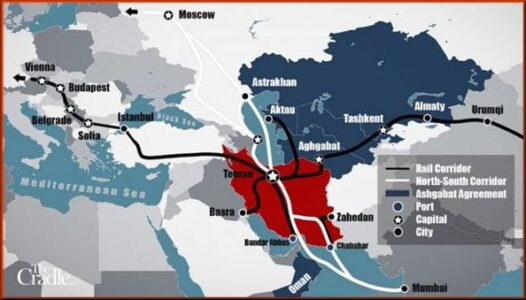 Ilie Bolojan also stated that “the Iași-Chişinău gas pipeline and the other projects currently being implemented to ensure the energy security of the Republic of Moldova ensure that most of Romania is supplied with electricity and natural gas.” The interim president also referred to transportation infrastructure. “The north-south transportation corridors are not yet sufficiently developed. For Romania, the road and rail infrastructure projects Via Carpathia and Rail-2-Sea remain priorities. In addition to the highway sections already completed, the entire Via Carpathia project on Romanian territory is in the tendering phase, covering almost 200 kilometers. In maritime terms, Constanta, the largest port on the Black Sea, confirms its strategic position as an important hub of the Europe-Caucasus-Asia international transport corridor. In the context of the war in Ukraine and Romania’s accession to the Schengen area, its importance is increasing,” the head of state stressed. He wanted to emphasize that we have important projects with the Republic of Moldova: new traffic bridges over the Proet River and currently the construction of a new bridge in Ungheni is underway. “As for Ukraine, we are considering opening new border crossings and increasing the transit capacity of the existing ones,” Bolojan said.
Ilie Bolojan also stated that “the Iași-Chişinău gas pipeline and the other projects currently being implemented to ensure the energy security of the Republic of Moldova ensure that most of Romania is supplied with electricity and natural gas.” The interim president also referred to transportation infrastructure. “The north-south transportation corridors are not yet sufficiently developed. For Romania, the road and rail infrastructure projects Via Carpathia and Rail-2-Sea remain priorities. In addition to the highway sections already completed, the entire Via Carpathia project on Romanian territory is in the tendering phase, covering almost 200 kilometers. In maritime terms, Constanta, the largest port on the Black Sea, confirms its strategic position as an important hub of the Europe-Caucasus-Asia international transport corridor. In the context of the war in Ukraine and Romania’s accession to the Schengen area, its importance is increasing,” the head of state stressed. He wanted to emphasize that we have important projects with the Republic of Moldova: new traffic bridges over the Proet River and currently the construction of a new bridge in Ungheni is underway. “As for Ukraine, we are considering opening new border crossings and increasing the transit capacity of the existing ones,” Bolojan said.
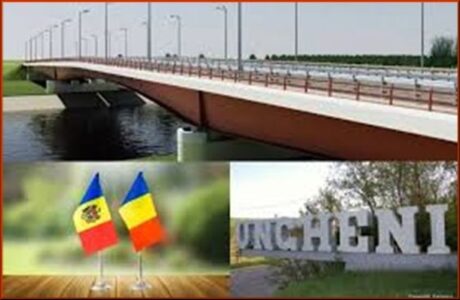 The interim president also referred to the digital transformation, stressing that we are engaged in global competition in terms of innovation and technological development and that we need to work together to develop state-of-the-art digital infrastructure in the region. The Romanian IT sector can contribute significantly to this effort. “It is essential to understand that the success of this initiative depends on our ability to benefit from the capital of private companies. The state cannot and should not be the only engine of development. Private companies bring not only financial resources, but also innovation and efficiency. In these uncertain times, unity and solidarity are more important than ever. My call is to turn challenges into opportunities and build together a more prosperous, secure and connected region,” President Bolojan said in his address. Duly noted!
The interim president also referred to the digital transformation, stressing that we are engaged in global competition in terms of innovation and technological development and that we need to work together to develop state-of-the-art digital infrastructure in the region. The Romanian IT sector can contribute significantly to this effort. “It is essential to understand that the success of this initiative depends on our ability to benefit from the capital of private companies. The state cannot and should not be the only engine of development. Private companies bring not only financial resources, but also innovation and efficiency. In these uncertain times, unity and solidarity are more important than ever. My call is to turn challenges into opportunities and build together a more prosperous, secure and connected region,” President Bolojan said in his address. Duly noted!
Financial sector
Victoriabank acquires Microinvest
Victoriabank, a bank in the Republic of Moldova owned by Banca Transilvania Financial Group, is acquiring Microinvest, the largest non-bank lender in the neighboring country.
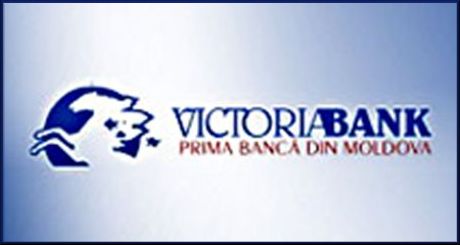 The acquisition will contribute to the growth of Victoriabank, the third largest bank in the Republic of Moldova, through diversification of offerings, the large number of new clients and expertise in microfinance.
The acquisition will contribute to the growth of Victoriabank, the third largest bank in the Republic of Moldova, through diversification of offerings, the large number of new clients and expertise in microfinance.
“The acquisition of Microinvest reflects Victoriabank’s growth trajectory, including through acquisitions. Microinvest is the company we have always looked up to with admiration, having redefined microfinance in the Republic of Moldova with innovative products and very good customer relations. We appreciate the success, the professionalism of the team and the positive impact on the local economy,” said Levon Khanikyan, president of Victoriabank.
Microinvest has 40,000 clients, both legal and natural persons, 350 employees and 17 branches. It finances SMEs, agricultural businesses and personal plans of customers.
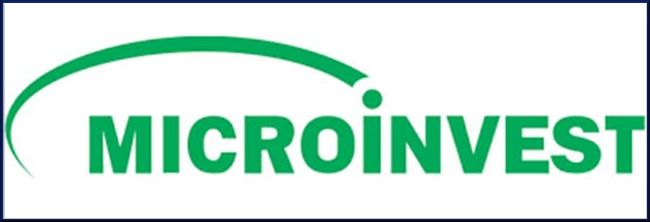 “Microinvest remains true to its mission: to provide accessible, personalized and responsible financing everywhere in Moldova. The support of a strategic shareholder like Victoriabank, part of the Banca Transilvania Financial Group, strengthens our ability to innovate, expand the range of financial products and get closer to customers in all regions of the country,” said Dmitrii Svinarenco, CEO of Microinvest.
“Microinvest remains true to its mission: to provide accessible, personalized and responsible financing everywhere in Moldova. The support of a strategic shareholder like Victoriabank, part of the Banca Transilvania Financial Group, strengthens our ability to innovate, expand the range of financial products and get closer to customers in all regions of the country,” said Dmitrii Svinarenco, CEO of Microinvest.
The transaction will be completed after approvals are obtained from the supervisory and regulatory authorities in Romania and the Republic of Moldova. Until then, Microinvest will operate independently.
“Microfinance is a special niche of the Banca Transilvania Financial Group, developed by BT Mic, BT Direct and Banca Transilvania. We want to replicate in the Republic of Moldova the success we achieved in Romania, both in supporting customers through microfinance and in terms of acquisitions,” said Bogdan Pleşuvescu, deputy managing director of Banca Transilvania.
Banca Transilvania Group worked with law firms and legal and tax consultants from Romania and the Republic of Moldova, Filip & Company, Vernon Î David și Asociatii and PWC, respectively, to evaluate and prepare the transaction.
Victoriabank recently completed its merger with BCR Chisinau. Victoriabank’s consolidated net profit for 2024 was over 1.1 billion lei, up more than 70% from 2023, and the volume of loans increased by more than 900 million lei.
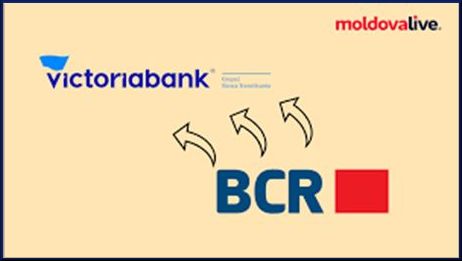 Banca Transilvania, BCR and UniCredit were on the podium of the largest banking groups of 2024, while CEC dropped to 4th place, with assets of about 99.3 billion. lei, BRD dropped to 5th position, with assets of 88.5 billion. lei, Raiffeisenkas remains in 6th place, with assets of 82 billion lei and ING is in 7th place, with assets of 78 billion lei
Banca Transilvania, BCR and UniCredit were on the podium of the largest banking groups of 2024, while CEC dropped to 4th place, with assets of about 99.3 billion. lei, BRD dropped to 5th position, with assets of 88.5 billion. lei, Raiffeisenkas remains in 6th place, with assets of 82 billion lei and ING is in 7th place, with assets of 78 billion lei
Romania has highest annual inflation in March
Euro stat data show that Romania had the highest annual inflation rate of all EU member states in March, at 5.1%, followed by Hungary at 4.8% and Poland at 4.4%.
On the other hand, the lowest inflation rate was recorded in France (0.9%), Denmark (1.4%) and Luxembourg (1.5%).
At the EU level, inflation fell to 2.5% in March, from 2.7% in February.
In March 2024, the average rate at the European level was 2.6%.
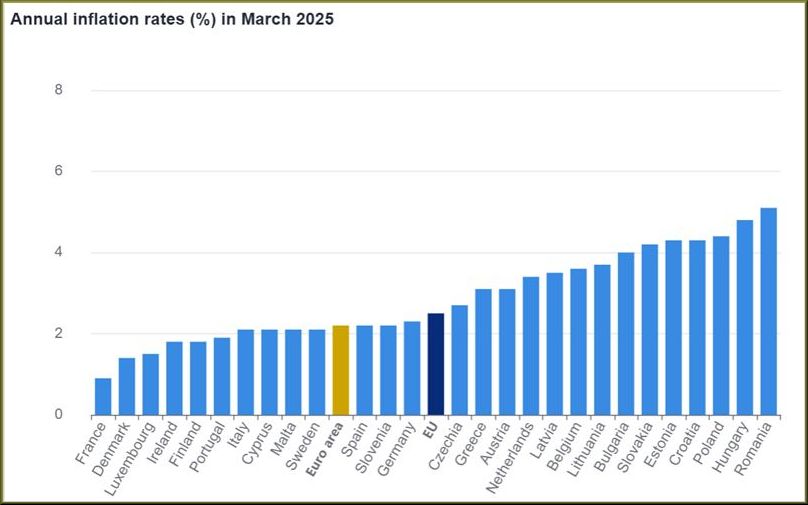
In the case of Romania, inflation has been on a downward trend in recent months, from 5.5% in December 2024. Our country returned to first place within the EU in March, after falling to second place in February, with a rate of 5.2%. This surpassed Hungary, which had an annual inflation rate of 5.7%.
The monthly inflation rate in March was 0.3%. By comparison, the highest monthly price increases were recorded in Greece at 1.9% and Portugal at 1.7%.
Romania made the fastest progress
Romania has made the fastest progress of all European Union countries in terms of real economic convergence. According to a report by the National Bank of Romania, more than half of its deficit with the euro area (on a purchasing power parity basis) has been made up.
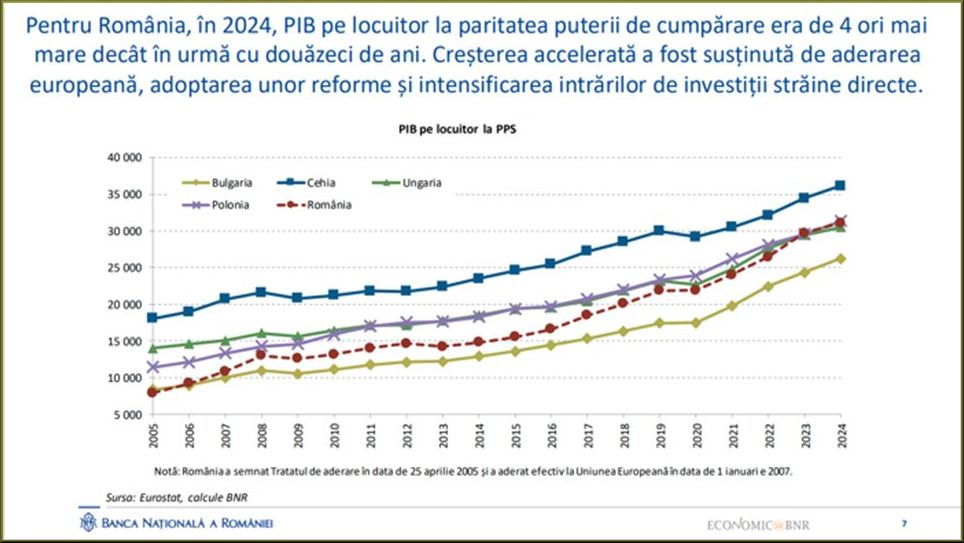
According to the same report, GDP per capita in Romania in 2024 on a purchasing power parity basis was four times higher than 20 years ago. Accelerated growth was supported by EU accession, the introduction of reforms and the intensification of foreign direct investment inflows.
Transport & Logistics Sector
E.van Wijk takes final step to continue under one name
We are one:
E.van Wijk Forwarding
Step by step to one organization
One organization one name
As of 2025, it is time to take the final step and also continue under one name. This consolidation will enable us to serve you even better with high-quality logistics solutions. Of course with the same reliable service and expertise that you have come to expect from us.
Learn more
Are you interested in our storage and transshipment possibilities in combination with inland shipping via the Twente Canal? Then we would like to invite you for a tour of our facility in Almelo.
Visit us
Columbus 5
7609 RM Almelo (NL)
Automotive Sector
Tesla expands in Romania
American electric car manufacturer Tesla is opening a new showroom in Timisoara this month. Its construction is nearing completion.
Tesla, which sold fewer and fewer cars in some European markets in April, is continuing its expansion plans in Romania. This month, the company will open a new showroom in Timisoara. Its construction is almost complete, according to orasul-timisoara.ro. At the same time, a service center will be opened near the showroom. This service center is expected to be operational from June.
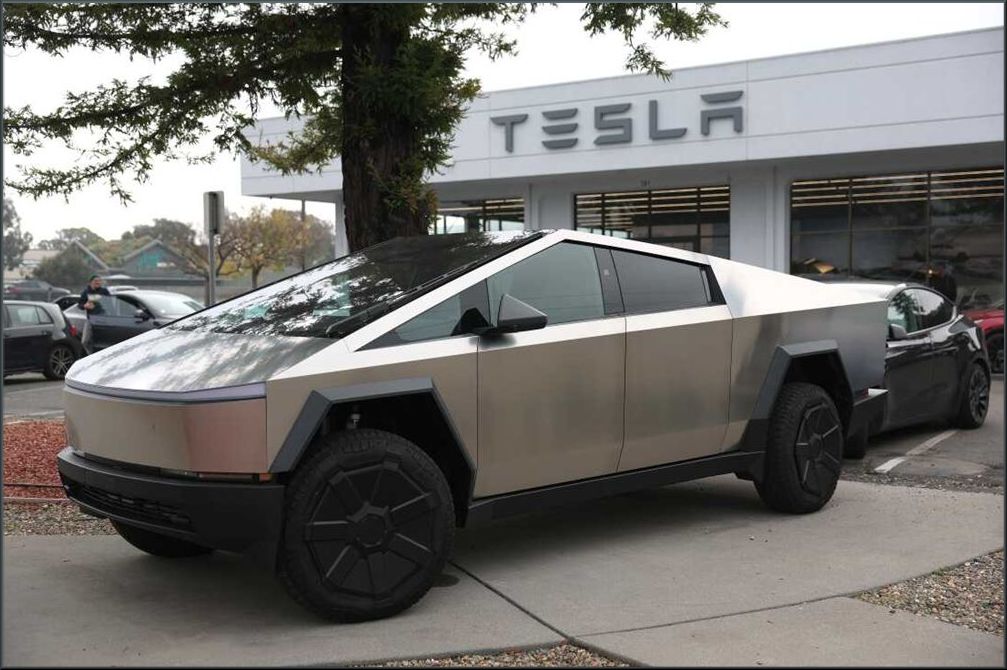
In addition, Tesla could open a third Tesla showroom in Romania, in Cluj-Napoca, by the end of the year. Currently, Tesla has a showroom in Bucharest and two pop-up stores in Timisoara and Cluj-Napoca.
Sales of Tesla electric cars plunged in some European countries in April as Europeans buy more Chinese electric cars and some protest against Tesla founder Elon Musk’s political views, Reuters reports. Data published earlier by the European Automobile Manufacturers Association (ACEA) showed that Tesla registrations in Europe fell 28.2% in March from a year earlier. Recently published national data show that in April the number of Tesla registrations in Sweden fell 80.7%, to the lowest level since October 2022. In the Netherlands, the number of Tesla registrations fell 73.8%, while it dropped 67.2% in Denmark and 59.4% in France.
ZF Transport,Logistics and Automotive 2025 -ZF Conference
Recently, very extensive conference took place where almost all issues were discussed and where short-term developments received attention, such as developments of industrial parks, driver crisis, customs issues, expansion of railroad structure, better connection with Moldova and Ukraine,third ring Bucharest, electric vehicles, etcetera.

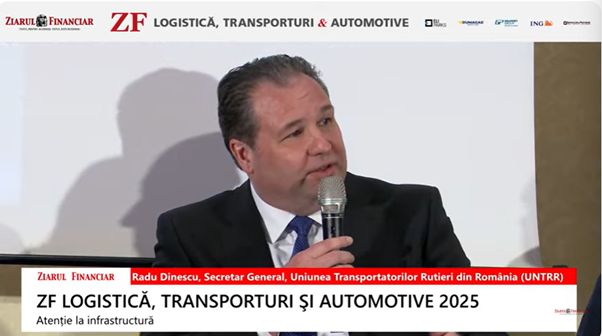
No theoretical stories but the logistics entrepreneurs themselves came to speak. The report on this meeting is too extensive for the newsletter, but you can read it by clicking here this important information anyway
Agricultural sector
Notes on horticulture in Moldova
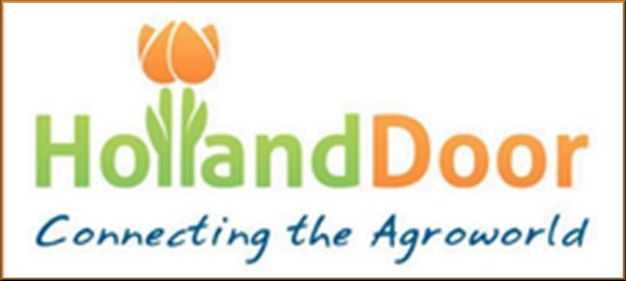 “The Netherlands has the expertise, technologies and networks needed to support Moldova in improving the productivity and quality of its horticultural sector,” says experience expert Jos Leeters of HollandDoor. An opportunity seminar on the horticultural sector in Moldova was held at the World Horti Center in Naaldwijk on Thursday, March 27.
“The Netherlands has the expertise, technologies and networks needed to support Moldova in improving the productivity and quality of its horticultural sector,” says experience expert Jos Leeters of HollandDoor. An opportunity seminar on the horticultural sector in Moldova was held at the World Horti Center in Naaldwijk on Thursday, March 27.
Jos explains that Moldova has a rich horticultural tradition. “It is a small player in global horticulture, but in recent years it has developed into a strong player in the European fruit sector.”
Briefly,
Moldova is a fruit-exporting country, for vegetables, however, an importing country.
- 000 Ha for this sector, with fruit comprising 150,000 Ha, 115,000 Ha for grape growing. Focus on modernization at 20% of companies exporting fruit, this is already at a fairly high level. By comparison, the Netherlands has 20,000 Ha of fruit
- 80% small holders still deserve a lot of attention, this so-called second shell also contains the future potential, given the many positive things such as the fertile chernozem soils
- Legislation regarding cooperatives does not allow much cooperation, cooperatives are still considered too much as propaganda and too little as vehicles for efficiency
- Scope for non-producers through contract farming and agregators or integrators
- EU has earmarked many funds in view of 2030 accession 1.9 billion Growth Fund, see Moldova Opportunity annex plan
- Vegetable sector still has much to do.
For a more comprehensive report and appendices, please visit jos@hollanddoor.nl
Romanian fruit and vegetable crops hit by bad weather
As in Bulgaria, growers in Romania have also been severely affected by bad spring weather.
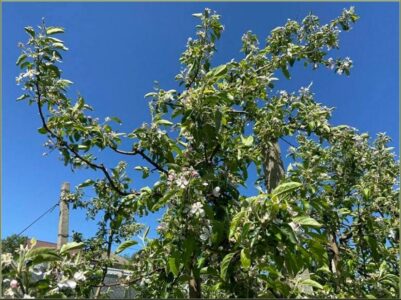 Vegetable and fruit growers have called for urgent government intervention after recent late spring frosts destroyed much of Romania’s horticultural production, according to Ziarul Financiar, quoting a message from the Association of Agricultural Producers Groups and Organizations “Fruleg-Ro.”
Vegetable and fruit growers have called for urgent government intervention after recent late spring frosts destroyed much of Romania’s horticultural production, according to Ziarul Financiar, quoting a message from the Association of Agricultural Producers Groups and Organizations “Fruleg-Ro.”
Their message indicates that imports and prices of food and vegetables will rise this year, with a significant impact on inflation and the trade deficit.The “Fruleg-Ro” association, which includes the 50 largest national cooperative organizations, warned that extreme weather between late February and April led to almost complete crop failure, with devastating effects on the sector and rural employment. 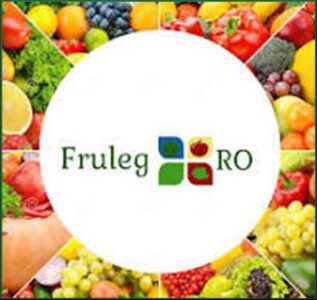
Romania grows fruit on more than 140,000 hectares and vegetables on 93,000 hectares. Annually, these sectors produce 1.4 million tons of fruit and 2.3 million tons of vegetables.
Fruleg-Ro warned that without compensation, the consequences of this year’s losses could be irreversible, referring to the long-term consequences of orchard abandonment. “An abandoned orchard, where no specific protection measures are applied, has minimal chances of recovery, even in a favorable meteorological context,” the association said.
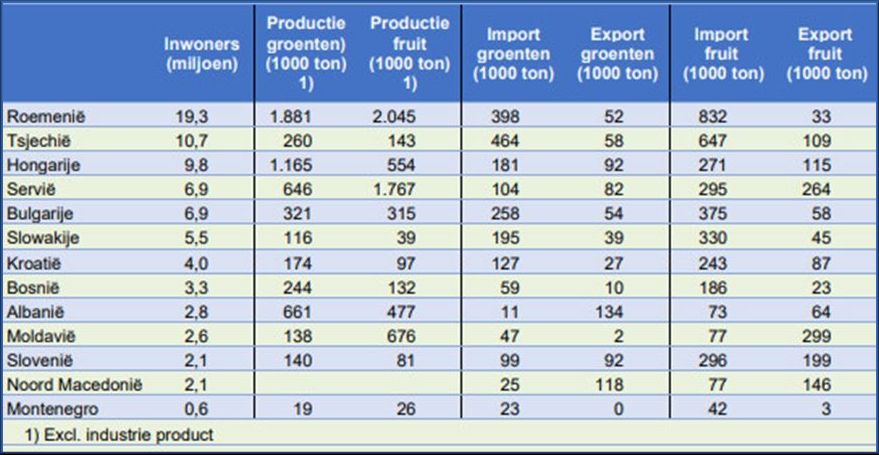
Romania already depends on imports for a significant portion of its fruit and vegetable consumption; 40% of fruits and 25% of vegetables come from abroad. By 2023, fruit imports reached 915,000 tons, worth €940 million, with major suppliers such as Turkey, Greece, Germany and Poland.
Fruleg-Ro warns that without government support, dependence on imports will increase further, undermining Romania’s food and economic security.
Support for housing pigs
Romania’s Ministry of Agriculture plans to provide 1.4 billion lei in aid by 2025 for investments in building housing for pigs
For example, through the Pig Breeders Support Program, aid of up to 65% of the eligible value and up to 80% for young farmers, respectively, is provided for the establishment of housing sites in pig breeding, rearing and fattening farms, with the maximum eligible costs being €13,300/new site and €10,180/place in a retained farm.
Eligible beneficiaries are: PFA, individual/family farms, agricultural enterprises and legal entities that carry out activities in the pig sector and have the obligation to carry out the activity for a period of at least 10 years after the completion of the investment.
“As we promised, we are revitalizing the pork sector and restoring the strategic place it deserves in the national agricultural economy. Through this program, we offer Romanian farmers concrete support to develop and meet Romania’s need for domestically produced pork. It is an investment in Romanian food security,” said Minister Barbu.
According to the project, the total value of state aid is 1,400,000,000 lei and is provided from the state budget, through the budget of the Ministry of Agriculture, within the limits of the amounts approved by the annual budget laws.
“The total budget for the state aid scheme is divided into two separate components, as follows:
- Component 1 – Investments in new housing places in pig complexes for reproduction, rearing and fattening (…): 50% of the total value of state aid;
- Component 2 – Investments in housing places in pig complexes for reproduction, rearing and fattening with at least one zootechnical farm under protection (…): 50% of the total value of state aid,” the project said.
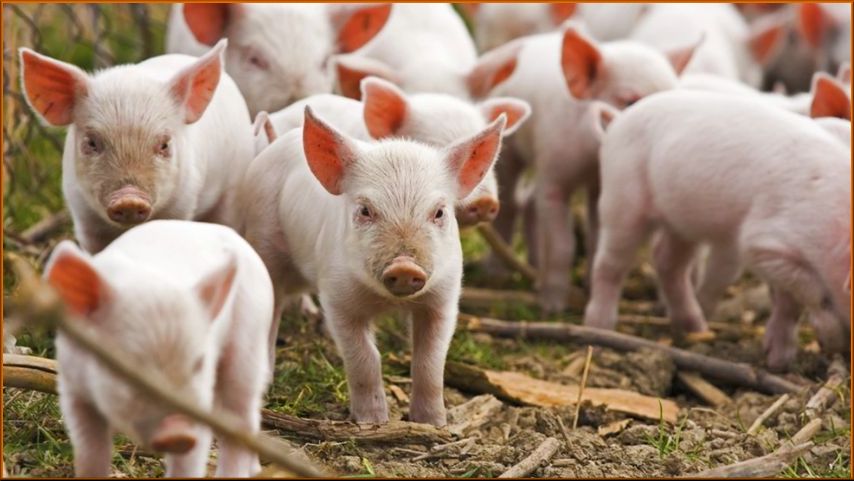
Applications for funding are submitted to the provincial agriculture departments and the Bucharest municipality, respectively, during the sessions announced by order of the Minister of Agriculture, accompanied by supporting documents such as: proof of land ownership, permits, feasibility studies, financial documents.
Projects are selected on the basis of the score obtained, depending on the production capacity or agricultural area owned. The maximum implementation period of the investment is 48 months from the signing of the contract, with the possibility of extension for up to 6 months.
According to statistical data from the draft regulations, the pig farming sector in Romania is in a sharp decline. Accordingly, the pig population has been continuously decreasing: 2020 – 3,784,507 head, 2021 – 3,619,581 head, 2022 – 3,328,734 head, 2023 – 3,154,053 head, 2024 – 3,015,178 head.
The coverage of consumption by domestic production also fell from 47% in 2022 and 46% in 2023 to 45% in 2024. The trade balance for 2024 showed a deficit of 122.8 million euros for live pigs and a deficit of 1.074 billion euros for pork.
Romanian wines – a well-kept secret
As an example, Murfatlar Wine once again confirmed its top position in the Romanian wine industry, picking up the most medals at the prestigious “Concours Mondial de Bruxelles 2025,” the session dedicated to rosé wines. The competition was held March 28-30 in Constanța, Romania, and brought together more than 1,200 wines from 34 countries. It reaffirmed the quality of the wines produced under the Murfatlar name.
The winery won five notable awards, including two Grand Gold medals – the highest honors awarded in the competition:
- Ovidiu’s Tear 5, Rosé – Grand Gold Medal, in the liqueur wine category
- Charme de la Mer, Rosé – Major gold medal, in the rosé wine category
- Arezan Cabernet Sauvignon, Rosé – Gold Medal, in the rosé wine category
- Aerosols Fetească Neagră & Pinot Noir, Rosé – Silver medal, in rosé wine category
- Statornic Cabernet Sauvignon, Rosé – Silver medal, in the rosé wine category.
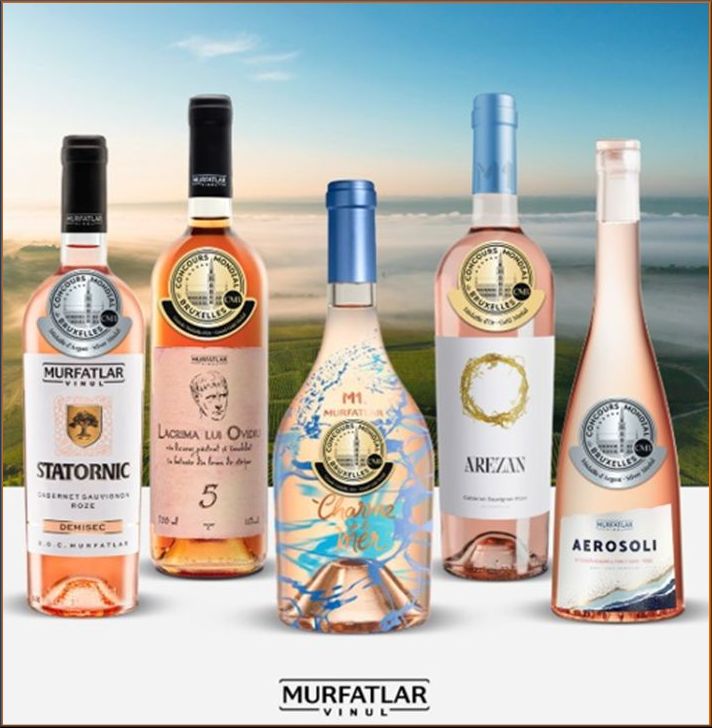
“It is a recognition that honors and empowers us. Every bottle of wine with the Murfatlar Vinul signature tells a story about terroir, about tradition, but also about innovation and passion. We are proud that our rosé wines are appreciated at the highest international level,” said Ionel Ilie , chief coenologist of the winery.
These achievements are the result of the work of a dedicated team, which puts the quality and identity of the wine at the center of all stages of production. Murfatlar Vinul continuously invests in technology, as well as human expertise, to continue the Dobrogea wine tradition in a modern and competitive manner.
Cosmin Popescu, Managing Partner Murfatlar Vinul , emphasized the importance of these results for the entire industry.
The fact that Romania hosted a prestigious international competition this year and Murfatlar Vinul was the most awarded winery shows that our wines have long since crossed local borders. It is a moment of pride for the brand, but also for Romanian wine as a whole. We will continue to meet consumer expectations and be a trusted ambassador of Romania on the international market.
The “Concours Mondial de Bruxelles” is one of the most respected wine competitions in the world. Every year, specialists from more than 50 countries gather to judge wines through rigorous blind tastings. Judging focuses on balance, complexity and technical quality. Romania’s selection as the host country in 2025 is an important first for the national wine scene.
Murfatlar Vinul’s performance during this edition confirms the winery’s mission to continue the excellence of Romanian wine, with respect for tradition and a clear vision for the future.
Shipbuilding sector
The House of Representatives passed the motion of Boomsma (NSC) et al. on April 3, 2025.
On April 3, 2025, the House of Representatives adopted the motion by Boomsma (NSC) et al. calling for the legal securing of space for framework-related companies and companies with a high environmental category in the upcoming National Spatial Policy Document. This explicitly mentions the maritime manufacturing industry as a sector of strategic importance.

This motion recognizes that maritime and offshore companies, often dependent on water-bound locations and specific infrastructure, are under pressure from spatial transformations. The Chamber emphasizes the importance of this sector to the strategic autonomy and sustainable earning capacity of the Netherlands.
The motion aligns perfectly with the Maritime Manufacturing Sector Agenda, which calls for spatial protection of maritime business parks. The agenda states, ” Quays and maritime business parks are essential. This activity cannot relocate and deserves structural assurance in policy ” (p. 21).
As NMT-IRO, we welcome this political signal. This is an important step towards future-proof investments in sustainability and innovation within our sector. We thank the movers of the motion, MPs Boomsma(NSC), Meulenkamp(VVD) and Vedder(CDA).
It remains a mystery that the state wants submarines made by French Naval which is a state-owned company and obviously a private company like Damen cannot compete with that. Simply put there is no level playing field and we call that distortion of competition.
As DRN, we will continue to monitor developments.
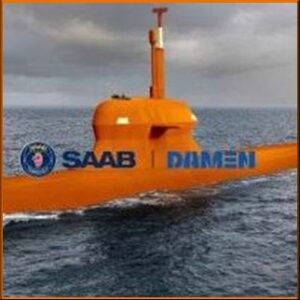 Damen Naval has awarded two major contracts to Van Halteren Technologies for the Anti-Submarine Warfare Frigate (ASWF)
Damen Naval has awarded two major contracts to Van Halteren Technologies for the Anti-Submarine Warfare Frigate (ASWF)
Program: the delivery of “Replenishment at Sea” (RAS) systems and “Helicopter Transfer Systems” (HTS). The ASW frigates, developed on behalf of the Dutch Ministry of Defense for the Royal Navy and the Belgian Navy, set a new European standard in advanced anti-submarine warfare.
Van Halteren Technologies was selected because of its expertise and strong track record, including previous successful collaborations with Damen Naval. Recently, the company successfully completed RAS testing for the Combat Support Ship (CSS) Den Helder. For the ASWF program, the integration of “RAS receivers” into superstructures is a key technical innovation.

Van Halteren Technologies Boxtel (VHT) is a Dutch company focused on designing and manufacturing specialized systems, technical solutions and services for defense and industry.
VHT’s RAS systems enable the safe transfer of liquids and solids at sea. They are fully customizable and work reliably even under severe operational conditions. In addition, VHT’s “Helicopter Transfer Systems” are suitable for both manned and unmanned helicopters.
“These contracts are another step in the development of a future-proof platform that contributes to European safety and cooperation. We enjoy working with partners like Van Halteren Technologies, who like us are committed to innovation,” said Fer Tummers, Project Director ASWF at Damen Naval.
“As a project, the Proven in Practice RAS and HTS systems will be fully integrated into the ASWF platform. For VHT, the contribution to the ASWF program is an excellent example to demonstrate the knowledge and expertise for Drive and Control technology in cooperation with Damen Naval,” said Charles Simons, Sales Manager Naval Systems at VHT.
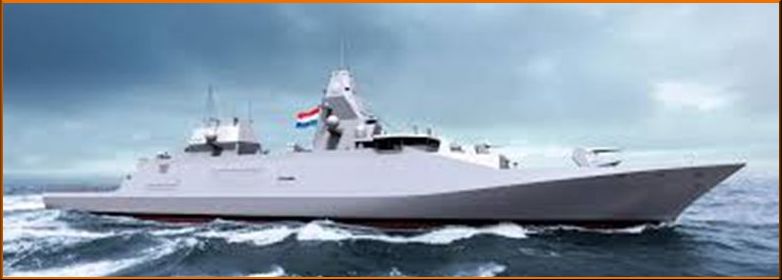
The new ASW frigates will replace the current Karel Doorman-class ships. They are specifically designed for anti-submarine warfare, but can also be deployed against threats from the air and from the water. The frigates have low noise emissions, advanced sensors, smart automation and high survivability. They are also suitable for missions such as counter-piracy and counter-terrorism, as well as maritime security tasks.
The ASWF program is a concrete example of European defense cooperation in practice and provides an opportunity for other EU and NATO countries to join. Delivery of the first ship is scheduled for 2028.
Damen signed a contract on April 15 with Arena Offshore A.S. in Instanbul for the construction of Stan Tugs 1606.
This is for the local construction of two Stan Tugs 1606. Damen Technical Cooperation (DTC) will supervise and provide assistance. In doing so, Damen offers customers worldwide customized support and shares the knowledge and technology needed to build its proven vessels at a external yard. Tug evolution With Damen’s design and license, Arena Offshore will build the Stan Tugs 1606 at its own facilities in Istanbul. After that, the company will offer the vessels for sale. Arena Offshore is a specialist in ship brokerage, chartering and shipbuilding. Since its inception in 1998, the company has built and delivered more than 50 newbuildings worldwide. The Stan Tug 1606 is a vessel that has proven itself in service for many years. The vessel has continuously evolved through the generations based on customer feedback. The 16.76 x 5.94 meter tug offers a bollard pull ahead of 16 tons. It is a versatile vessel, well suited for towing, mooring, pushing and inspection operations. Quality vessels and economic boost M. Ömer Ince, owner of Arena Offshore, said, “It is a great honor and pleasure for us that Damen has chosen and trusted an external company, Arena Offshore, to build two Stan Tugs 1606, one of their best-known models. As a token of this trust, we are delighted to complete the construction of the two units in Istanbul.
external yard. Tug evolution With Damen’s design and license, Arena Offshore will build the Stan Tugs 1606 at its own facilities in Istanbul. After that, the company will offer the vessels for sale. Arena Offshore is a specialist in ship brokerage, chartering and shipbuilding. Since its inception in 1998, the company has built and delivered more than 50 newbuildings worldwide. The Stan Tug 1606 is a vessel that has proven itself in service for many years. The vessel has continuously evolved through the generations based on customer feedback. The 16.76 x 5.94 meter tug offers a bollard pull ahead of 16 tons. It is a versatile vessel, well suited for towing, mooring, pushing and inspection operations. Quality vessels and economic boost M. Ömer Ince, owner of Arena Offshore, said, “It is a great honor and pleasure for us that Damen has chosen and trusted an external company, Arena Offshore, to build two Stan Tugs 1606, one of their best-known models. As a token of this trust, we are delighted to complete the construction of the two units in Istanbul.
Fugro and Damen have joined forces to provide the Royal Navy (KM) with a surveillance vessel and crew.
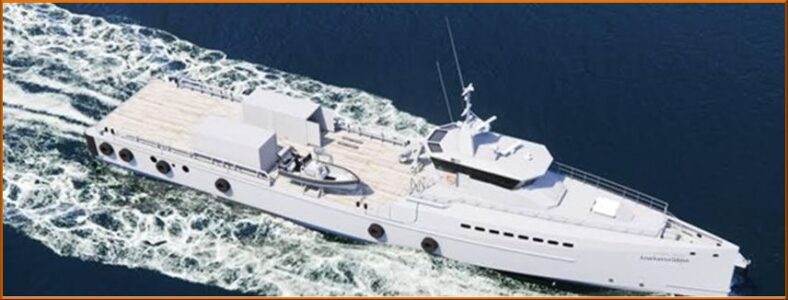 The Department of Defense has entered into this new partnership to strengthen its maritime
The Department of Defense has entered into this new partnership to strengthen its maritime 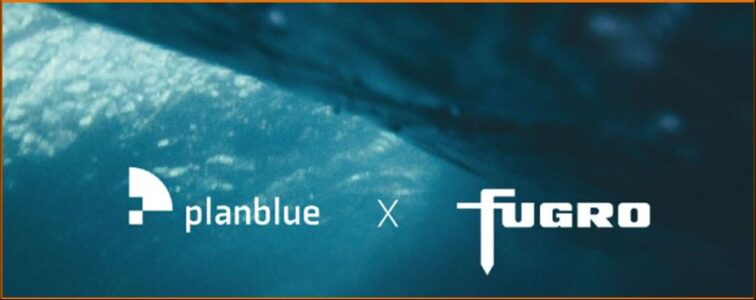 security and surveillance capabilities.
security and surveillance capabilities.
KM will use the surveillance vessel for security operations within the exclusive economic zone (EEZ) of the Dutch North Sea, both above and below water.Using advanced technology, such as unmanned vehicles, it will enable KM to monitor the activities of ships in the North Sea and inspect critical underwater infrastructure, such as cables and pipelines. Fugro and Damen have formed a joint venture to provide the vessel and crew for a two-year charter period, with an option for two one-year extensions (a total of four years). The charter agreement, awarded through competitive tender, will commence in the first half of 2025. The vessel that will perform the charter is a 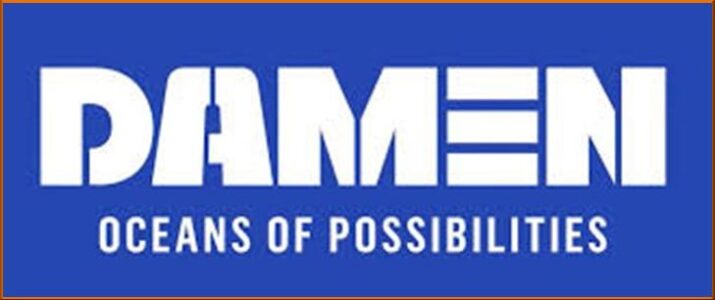 Damen FCS 5009, which offers unparalleled
Damen FCS 5009, which offers unparalleled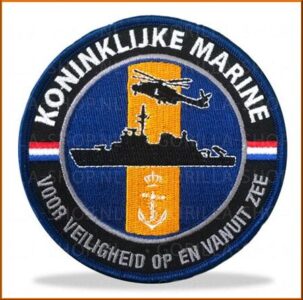 seaworthiness thanks to its Sea Axe bow design, developed in collaboration with Delft University of Technology. “We are very proud of this collaboration with Fugro and the confidence the Ministry of Defense has placed in us to execute this important contract,” said Arnout Damen, CEO of Damen Shipyards Group. “Damen’s way of working means we can deliver a vessel quickly and work with Fugro at short notice to monitor and protect the Netherlands’ strategic interests in the North Sea.” “At Fugro, our mission is to create a safe and livable world. Keeping our underwater infrastructure in the North Sea safe is essential to this, and by working with Damen and the Royal Netherlands Navy we can contribute to national security and surveillance. We have previously presented our experience in monitoring critical underwater infrastructure to the Dutch Ministry of Defense and look forward to continuing to work with them. We are also excited to partner with Damen in this endeavor. Damen has a long history of supplying vessels to the Royal Navy and Fugro. By joining forces, we demonstrate the innovative strength of the Dutch maritime industry,” said Mark Heine, CEO of Fugro.
seaworthiness thanks to its Sea Axe bow design, developed in collaboration with Delft University of Technology. “We are very proud of this collaboration with Fugro and the confidence the Ministry of Defense has placed in us to execute this important contract,” said Arnout Damen, CEO of Damen Shipyards Group. “Damen’s way of working means we can deliver a vessel quickly and work with Fugro at short notice to monitor and protect the Netherlands’ strategic interests in the North Sea.” “At Fugro, our mission is to create a safe and livable world. Keeping our underwater infrastructure in the North Sea safe is essential to this, and by working with Damen and the Royal Netherlands Navy we can contribute to national security and surveillance. We have previously presented our experience in monitoring critical underwater infrastructure to the Dutch Ministry of Defense and look forward to continuing to work with them. We are also excited to partner with Damen in this endeavor. Damen has a long history of supplying vessels to the Royal Navy and Fugro. By joining forces, we demonstrate the innovative strength of the Dutch maritime industry,” said Mark Heine, CEO of Fugro.
Post Craiova

Meet Peter Rottier: Arable farmer in Romania
As you may have noticed, the perceived differences between Romania and the Netherlands are also a popular topic of conversation in my private life. Especially in conversations with other entrepreneurs in our small Dutch/Belgian community in Craiova. This gave me the idea to occasionally highlight in Post Craiova the perspectives of other Dutch and Belgian entrepreneurs operating in the same region.
This time we hear from an entrepreneur from a completely different sector than ours, but a pioneer nonetheless. Peter Rottier has been running an arable farm in Romania since 2015, managing a whopping 4,200 hectares of farmland. That’s a lot. The average farm size in the Netherlands is 30 to 40 hectares, and in Romania it is only 2.8 hectares. This is because agriculture here is generally still very small-scale and fragmented, a relic of days gone by.
 Peter has built a thriving company from nothing in ten years, with 57 employees and constant technological innovation at its core.
Peter has built a thriving company from nothing in ten years, with 57 employees and constant technological innovation at its core.
In my opinion, he practices what I call “common sense” entrepreneurship. Step by step, he continuously tries to optimize and use the available resources as efficiently as possible. This is certainly not a given for Dutch entrepreneurs in Romania, but at the same time it is a huge advantage: Peter speaks fluent Romanian.
Peter says, “Being able to start this business is a dream come true. I always had the ambition to become a farmer and grow crops; my whole education and career were focused on that. The Netherlands offers a great base of knowledge, technology, logistics and markets.
But starting a farm from scratch is almost impossible financially. So moving abroad is really the only option.”
Romania came my way through an entrepreneur who was looking for someone with knowledge of plant cultivation. Well, I got that. This partner was ultimately not interested in working in the Romanian countryside, but I thought: it’s now or never.
Together with a Belgian family, I was able to take over a grain farm. Grain is an easy crop to grow and the soil in the Craiova region turned out to be very good and suitable even for several other crops. Since 2019, we started growing peonies on a few hectares. Thanks to our market in the Netherlands, we were able to scale up considerably within a few years. I have invested in things like harvest belts, cold stores, etc., and in training skilled permanent employees, who are now real product specialists. Because we want to retain their knowledge and make the best use of the technical resources we have invested in, we also started growing rose hips, which are used as ornamental plants in the flower trade. Through clever spreading with different crops, we are now active almost all year round. What I love about Romanian employees is that they really go for it. They are loyal and flexible, and they don’t mind working a few extra hours. Of course, as an employer, you also have to be willing to bend a little with them sometimes. That is perhaps the biggest contrast with the Netherlands, where everything is laid down to the minute in rules and procedures. 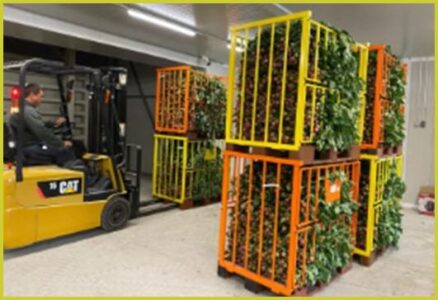
In a relatively short time, Peter, like me, has seen Romania change considerably. He tells how he has experienced it: “What I really like is that the development of our company actually runs parallel to the development of the country. We started all over again and got it right from the beginning, investing in the latest technology, without being hampered by the need to replace old technology. You see the same trend throughout Romania, especially in the cities. When I moved to Romania, people in the Netherlands wished me success.
Now, when I get visitors, they often don’t notice any difference between Craiova and other big cities in Western Europe. Especially the younger generation is not much different in attitude and mentality from their peers throughout Europe.” Peter’s story demonstrates once again that doing business in Romania is much less exotic than it first appears, and the differences are rapidly shrinking. The professionalization and scaling up of the Romanian countryside is in full swing, largely thanks to the tireless efforts of people like Peter Rottier and the approximately 3,500 Dutch entrepreneurs who, together with him, operate in Romania.
Disclaimer

The newsletter of the Dutch Romanian Network is compiled with great care. The Dutch Romanian Network cannot accept any liability for a possible inaccuracy and/or incompleteness of the information provided herein, nor can any rights be derived from the content of the newsletter. The articles do not necessarily reflect the opinion of the board.
